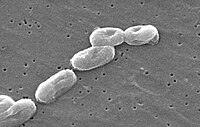
Photo from wikipedia
Gram-negative bacteria can alter the structure of their LPS to promote resistance to cationic antimicrobial peptides, including polymyxin antibiotics. Polymyxins are considered last-resort antibiotics for treatment against multidrug-resistant Gram-negative organisms.… Click to show full abstract
Gram-negative bacteria can alter the structure of their LPS to promote resistance to cationic antimicrobial peptides, including polymyxin antibiotics. Polymyxins are considered last-resort antibiotics for treatment against multidrug-resistant Gram-negative organisms. Here, we explore how changes in general metabolism and carbon catabolite repression pathways can alter LPS structure and influence polymyxin resistance. ABSTRACT Gram-negative bacteria have a unique cell surface that can be modified to maintain bacterial fitness in diverse environments. A well-defined example is the modification of the lipid A component of lipopolysaccharide (LPS), which promotes resistance to polymyxin antibiotics and antimicrobial peptides. In many organisms, such modifications include the addition of the amine-containing constituents 4-amino-4-deoxy-l-arabinose (l-Ara4N) and phosphoethanolamine (pEtN). Addition of pEtN is catalyzed by EptA, which uses phosphatidylethanolamine (PE) as its substrate donor, resulting in production of diacylglycerol (DAG). DAG is then quickly recycled into glycerophospholipid (GPL) synthesis by the DAG kinase A (DgkA) to produce phosphatidic acid, the major GPL precursor. Previously, we hypothesized that loss of DgkA recycling would be detrimental to the cell when LPS is heavily modified. Instead, we found that DAG accumulation inhibits EptA activity, preventing further degradation of PE, the predominant GPL of the cell. However, DAG inhibition of pEtN addition results in complete loss of polymyxin resistance. Here, we selected for suppressors to find a mechanism of resistance independent of DAG recycling or pEtN modification. Disrupting the gene encoding the adenylate cyclase, cyaA, fully restored antibiotic resistance without restoring DAG recycling or pEtN modification. Supporting this, disruptions of genes that reduce CyaA-derived cAMP formation (e.g., ptsI) or disruption of the cAMP receptor protein, Crp, also restored resistance. We found that loss of the cAMP-CRP regulatory complex was necessary for suppression and that resistance arises from a substantial increase in l-Ara4N-modified LPS, bypassing the need for pEtN modification. IMPORTANCE Gram-negative bacteria can alter the structure of their LPS to promote resistance to cationic antimicrobial peptides, including polymyxin antibiotics. Polymyxins are considered last-resort antibiotics for treatment against multidrug-resistant Gram-negative organisms. Here, we explore how changes in general metabolism and carbon catabolite repression pathways can alter LPS structure and influence polymyxin resistance.
Journal Title: Journal of Bacteriology
Year Published: 2023
Link to full text (if available)
Share on Social Media: Sign Up to like & get
recommendations!